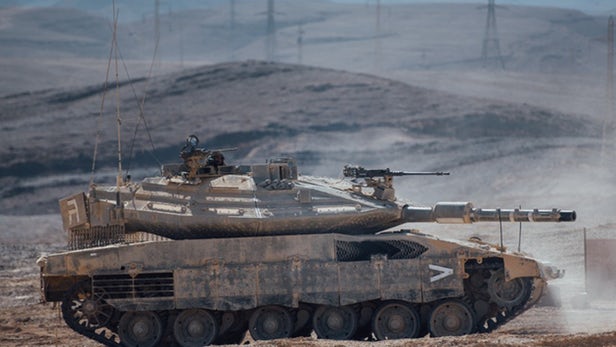
Image Credit: IDF
The defence sector is a demanding industry as companies from all over the world compete for new innovations and technologies. From tanks and armoured personnel carriers to autonomous vehicles and helicopters, countries are always looking to expand their defence forces.
We’ve recently covered some really interesting defence technologies ranging from micro drones to UAVs and military robots. Looking at some of the developments from 2018, the Israeli Defence Force springs to mind.
Israeli Defence Forces Merkava Development Programme
Dating back to 1970, the IDF (Israeli Defence Force) started developing the “Merkava”, which translates to “chariot” and made four models. Derived from IDF’s initial development programme, the Merkava officially entered service in 1979 where the Israeli Defence Forces extensively used the Merkava in the 1982 Lebanon War.
The design criteria of the original Merkava included rapid repair of battle damage, increased survivability, cost-effectiveness and impressive off-road performance. With self-propelled howitzers in mind, the turret is more to the rear compared to most main battle tanks. This layout means the engine is in the front granting additional protection against a frontal assault. As a result, the tank can absorb some of the force from incoming shells, especially important for the personnel in the main hull.
There is also more space in the rear that provides more storage capacity. The rear entrance to the main compartment means safer and easier access under enemy fire. As such, the tank is a platform for medevac, a forward command and control station and an armoured personnel carrier. When ammunition is offloaded, the tank can carry up to eight dismounted soldiers or three stretchers.
The IDF intended to stop production of the Merkava tanks shortly before the 2006 Lebanon War but on November 7, 2006, everything changed. According to reports, an Israeli General staff assessment had ruled that, “if the Merkava Mark IV was properly deployed, the tank could provide its crew with better protection than in the past”. In August 2013, Israeli Defence Minister, Moshe Ya’alon announced that they will resume production of the Merkava main battle tank for the IDF Armoured Corps.
Merkava MK4 Barak Smart Tank
Previous versions of the Merkava battle tank include the Mark II, Mark III and Mark IV with several versions in-between. There were three newer models of the Mark II as well as the Mark IV Windbreaker equipped with APS (Active Protection System). While they all had unique features and functionalities, everything has led to the Merkava Mk4 Barak Smart Tank.
Defence and Artificial Intelligence
In addition to the combined features from previous versions, the Mk4 Barak adds artificial intelligence to armoured combat. The Mk 4 Barak is one of the first tanks to use an advanced AI and sensor system taking over several routine tasks. This means that the crew can focus more on the job at hand resulting in improved combat awareness and efficiency.
According to the IDF, the advanced AI system improves mission times by 30 percent and also helps identify and attack enemy targets faster and more accurately. The advanced computer system shares data with crew and other tanks in the vicinity which allows for advanced mission control.
As a senior official from the Armoured Corps stated, “The advanced defence capabilities and the use of electronic means will prepare the combat soldiers to carry out missions according to the level of urgency. Along with all this, additional logistical improvements will also be introduced that will enable the tank to carry out missions that are up to 30% longer than current ones.”
Iron Vision VR Helmet
The IDF began trials in mid-2017 of Elbit’s Iron Vision helmet-mounted display for tanks. Elbit first developed the display system for the F-35 fighter jet but now also forms part of the Mk4 Barak. The Iron Vision uses a number of externally mounted cameras to provide soldiers with a 360° view of the tank’s surroundings.
Not only does the Iron Vision VR Helmet provide better situational awareness but it also offers trainees a more realistic experience during combat exercises. The IDF believes that the VR Helmet makes the transition from combat training to real tank missions much smoother. The sensors allow the soldiers to operate the tank in a simple and advanced way, contributing to its defence physically and technologically.
According to an unnamed Armoured Corps senior official, “The Armoured Corps concludes a significant period of operational successes in various regions, which proves the relevance of the corps in protecting the security of the State of Israel and its civilians. The new tank brings the Armoured Corps a step forward in the operational arena, and constitutes an innovative weapon that will change the face of the combat on the ground.”
VR Helmet In Action
Take a look at how soldiers train using the VR helmet in this video courtesy of the Israeli Defence Force.
The Mk 4 Barak is the latest battle tank and trials are scheduled to begin in 2020. For more interesting updates on military technologies, aerospace, automotive, rail, oil and energy among others, follow our weekly blog posts.
We have worked with the defence industry for more than 6 years to help develop new products and now we work routinely in all areas of defence providing all sorts of products and services. Get in touch if you require a professional, experienced engineering company to assist with your project.
This site uses Akismet to reduce spam. Learn how your comment data is processed.


 Mail:
Mail: 




Leave a Comments